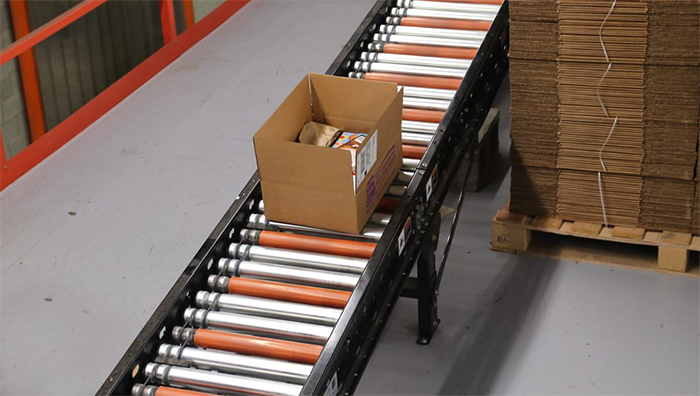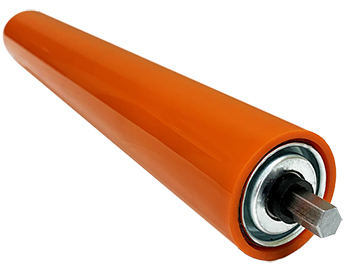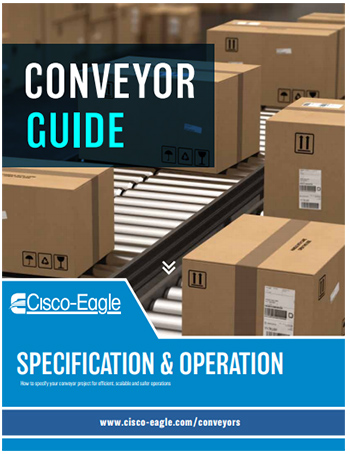Applications for Urethane Sleeved Conveyor Rollers
Ideal for grip, resistance to chemicals and moisture

Above: urethane rollers used on an incline distribution application.
Roller conveyors are galvanized steel, and are sleeved in urethane for specific applications. These rollers can be used almost anywhere and are often specified for food & beverage, printing, automotive and medical/pharmaceutical operations. When should your conveyor utilize urethane rollers?
Typical uses for urethane rollers
Urethane rollers protect conveyed products
Belt conveyors—which protect conveyed items better than rollers—are the usual choice for fragile load conveying, but sometimes it’s you need the roller.
Urethane is less likely to imprint, mar or mark packages, which makes it ideal for fragile loads. If you need to convey finished packages on rollers, coated rollers will protect them from markings. Coated rollers are ideal when you need to convey a load that could be marred, indented or scratched by metal.
Read more: Conveyors: Belt or Roller? A Matter of Function and Situation

A sure grip and shock reduction
Although most incline conveyor applications are accomplished with belt-over-roller systems, urethane rollers let you convey on an incline due to their ability to grip a carton without allowing it to slide or stall when conveyed on an incline.
Because urethane rollers reduce shock and vibration, they’re used for live roller conveying situations that require precise positioning and stability—think of loads with very smooth bottoms like glass, stainless steel, wood, or sheets of other types. Urethane can provide the traction needed to convey these items—it can increase traction up to 15% compared to uncoated metal rollers.
When rollers are subjected to abrasion from higher friction or dynamic loads, urethane is better than rubber, which isn’t as durable. Its ability to resist wear is important for publishing and printing applications.
Sleeve your rollers to ensure traction, position and grip during belt-to-roller transitions.
Use poly rollers in extreme-temperature areas
Some conveyor applications may require high temperatures, either in part or whole. Drying, curing, or freezer areas are good examples of these needs, which are part of many manufacturing processes. If your application requires a sleeved roller, polyurethane is a better option than vinyl or rubber due to its ability to function in these very cold or very hot areas.
Durability and longevity: Due to its tensile strength and elongation, urethane can handle more weight than most sleeve alternatives without rupturing. This lets you run conveyors faster and and longer, under more weight. It resists permanent sleeve material indention so it maintains its basic shape and functionality. This also makes your rollers last longer, which reduces maintenance and replacement costs.
Protecting the rollers: Poly sleeves not only protect products conveyed on the roller–they protect the rollers themselves from abrasion, dents and wear.
Noise reduction: One of the reasons urethane is specified is its noise reduction properties. A quieter operation is always desirable, so finding ways to reduce background noise is always helpful in creating a more ergonomic workplace.
Read more: Conveyors in Difficult Environments
Applications for poly rollers
Polyurethane is ideal for food conveying and handling applications because it resists cuts and abrasions–and it’s FDA-approved. Because of its superior resistance to solvents, chemicals and other harsh external factors, urethane is a better choice than rubber for those applications. Polyurethane won’t corrode in wet or submerged applications.
Other applications include woodworking, plastics, steel, packaging, beverage conveying, printing and glass handling. Also, use poly sleeved rollers for incline conveying. Poly rollers are frequently used for clean rooms and areas where washdown is necessary.
More resources
Download Cisco-Eagle’s guide to conveyors & systems
Well-executed conveyors and systems will optimize your operation–and we can help you make that happen. Cisco-Eagle’s detailed guide to conveyors gives you advice from our expert employee-owners, links, articles and more.
Download the guide today
Scott Stone is Cisco-Eagle's Vice President of Marketing with 35 years of experience in material handling, warehousing and industrial operations. His work is published in multiple industry journals an websites on a variety of warehousing topics. He writes about automation, warehousing, safety, manufacturing and other areas of concern for industrial operations and those who operate them.




